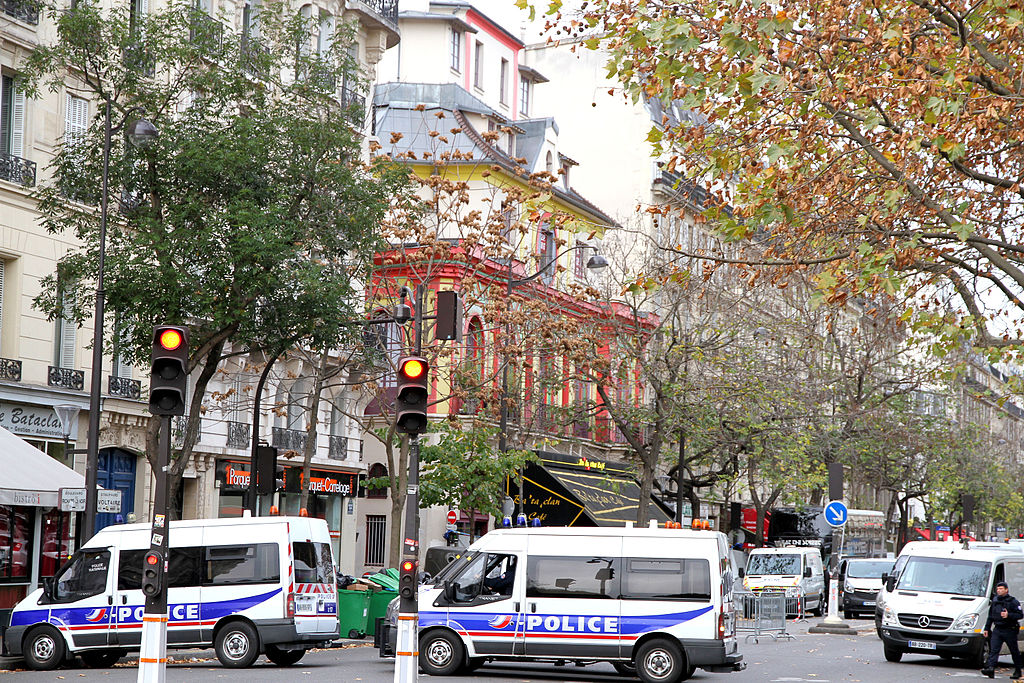On the 12th of November, Beirut was attacked when two suicide bombers killed 43 civilians and wounded many others. While the next day Paris suffered co-ordinated attacks throughout the city leaving 130 citizens dead and nearly four hundred injured. Both Daesh attacks were carried out by the militant group known as ISIL. These events are very tragic and it is hard to know how to react to them but the questions that come to mind when looking through the internet, are: what impact is social media having in the aftermath of these events? Does it help an ongoing situation when everyone is posting about the event as it happens? There are arguments on both sides, but I think there should be a call for people to think before they post on social media in times of an attack or disaster.

Outside the Bataclan theatre after the attack in Paris (Source: Wikipedia)
I found out about the attack on Paris the same way a lot of people did, through social media, and within the first few hours there were many different and conflicting stories coming from all areas of the Internet. It was hard to know which information was true, and which was false. Not being one to jump head first into a social media storm before I get the facts, I stayed away from the misinformation and blame that was coming from Twitter and Facebook. Shortly after hearing about the Paris attack I found out that Beirut was attacked earlier that day by two suicide bombers on motorbikes. Why was there no social media storm on this event? And why did it take the attack in Paris to highlight the Attack in Beirut? The answer could easily be that, being from Ireland my social media bubble is centred around Ireland and Europe, and that news articles from outside my bubble just don’t make it in. However, it does seem that the media did not give Beirut the same kind of coverage as Paris. Maybe that is because Europe is not used to having its capital cities attacked and when it does happen on our doorstep it makes these issues happening around the world very real.
In a study undertaken in 2015 on “Cyberhate on Social Media in the Aftermath of Woolwich,” where two men attacked and killed an off duty British army soldier to avenge the killing of Muslims by the British army. They researched what affect Social media (mainly Twitter) has on trigger events, which is a traumatic event that causes widespread panic like what happened in Paris. The conclusion they came to was that cyberhate is very much present in the first few hours after a trigger event (Williams and Burnap, 2015). What tends to happen in these situation is that people jump to conclusions or believe what they are being told without questioning its source, and then start posting hateful messages about ethnic groups or religions which they think are responsible. It is an opportunity for some people to express their bigotry and nurture a climate in which to back up their words. Misinformation is a big problem that came out on social media after the Paris attacks, there were several pictures and tweets posted about the events that had nothing to do with the attacks that were probably put up to incite a reaction and then retweeted without checking the facts. One such tweet that was circulating was one that Donald Trump tweeted about how one of the toughest countries on gun control can get attacked. This tweet was actually from the shooting in Paris in January and not about the latest attack, where he actually tweeted his sadness of the terrible events (“Misinformation Abounds Following Paris Attacks, 2015”).
Isn’t it interesting that the tragedy in Paris took place in one of the toughest gun control countries in the world?
— Donald J. Trump (@realDonaldTrump) January 7, 2015
Another image that was circulated was of a picture of a Canadian Sikh taking a bathroom selfie with his iPad, however someone had photoshopped the image and replaced the iPad he was holding with the Quran and also put a suicide vest on him (“Misinformation Abounds Following Paris Attacks, 2015”). This kind of Cyberhate can potentially put that man’s life at risk and ruin his reputation. These hateful uses of social media in emotionally heighten times just deepen the impact and can cause new events to happen through cyclical process of action, reaction and amplification (Williams and Burnap, 2015).
Portraying @Veeren_Jubbal as a terrorist puts his life at risk, ruins his reputation. This is online terrorism. pic.twitter.com/U5bJYCnIsC — Amy (@AmyStephen) November 15, 2015
Social media has helped in certain ways when a trigger event like Beirut or Paris happens. Parisians opened their homes through social media to people who needed a place to stay or seek refuge. Using the #porteouverte hashtag people could seek a safe place while the attacks unfolded (“Parisians Use Hashtag #porteouverte to Offer Their Homes as Shelter during Attacks, 2015”). Facebook for the first time used a new feature that they also used a few day later after the bombings in Yola a northeastern city of Nigeria. It lets people who are in an area affected by a disaster or attack to mark that they are safe (Egbejule, Eromo, 2015). There were questions about why it was only used in Paris especially with other recent atrocities in Beirut and Kenya. Facebook released a statement saying, that the original intent for the ‘Safety Check’ was for natural disasters but decided to change it to include human disasters also, and will be using it from now on (D’Onfro, Jillian, 2015). To conclude, social media in these time of trigger events is a crazy place full of angry, scared and destructive people who either react without thought or act to incite more hate and fear. The best thing I could advise is to step back from social media during these time and let the facts come out and don’t fuel the fire of misinformation and Cyberhate. Take a personal moment of reflection to think of everyone affected by these events and whether it would really help them to post your opinion on the events.
Bibliography:
- D’Onfro, Jillian. “Undefined.” Accessed November 21, 2015. http://widget.perfectmarket.com/wwwbusinessinsider/tbbfAd.html?wid=tbx-text-links-h&wmd=text-links-h&wpl=TBXbackfill640x110&ppn=tbx-network.
- Egbejule, Eromo. “Nigerians Welcome Facebook’s Safety Check Feature after Terror Attacks.” The Guardian, November 19, 2015, sec. World news. http://www.theguardian.com/world/2015/nov/19/nigeria-facebook-safety-check-boko-haram-bombing.
- Williams, Matthew L., and Pete Burnap. “Cyberhate on Social Media in the Aftermath of Woolwich: A Case Study in Computational Criminology and Big Data.” British Journal of Criminology, June 25, 2015, azv059. doi:10.1093/bjc/azv059.
- “Misinformation Abounds Following Paris Attacks.” CNBC. Accessed November 17, 2015. http://www.cnbc.com/2015/11/14/rumors-and-misinformation-circulate-on-social-media-following-paris-attacks.html.
- “Parisians Use Hashtag #porteouverte to Offer Their Homes as Shelter during Attacks.” Accessed November 19, 2015. http://www.cbc.ca/news/trending/paris-attacks-porte-ouverte-hashtag-shelter-1.3318906.

Leave a Reply